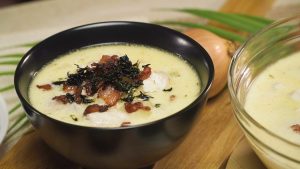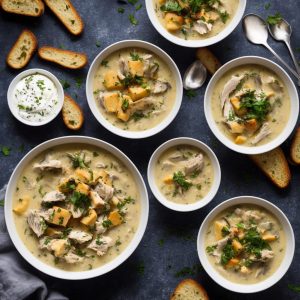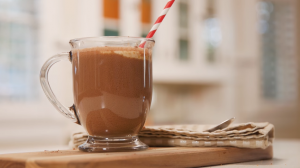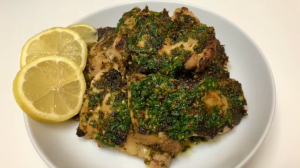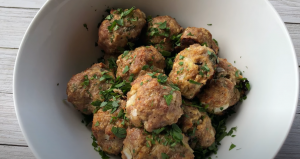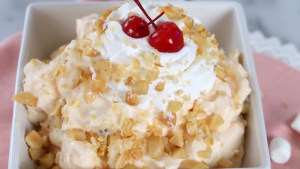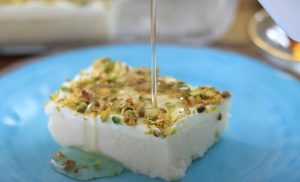Dive into a comforting bowl of fish chowder that melds the rich flavors of cod, potatoes, and cream. This hearty dish is perfect for chilly evenings or when you need a satisfying meal.
Photos of Fish Chowder Recipe
Some ingredients in this recipe might not be staples in your pantry. For instance, clam juice provides a seafood depth that can't be replicated with regular broth. Old Bay seasoning is another key component, infusing the chowder with a unique blend of spices. Make sure to look for these items in the soup or spice section of your supermarket.
Ingredients For Fish Chowder
Extra virgin olive oil: Provides a rich and smooth base for sautéing the onions.
Butter: Adds a creamy texture and enhances the flavor of the dish.
Yellow onions: Offers a sweet and mild taste that complements the fish.
Dry white wine: Adds acidity and depth of flavor to the chowder.
Yukon gold potatoes: Creamy and tender, these potatoes hold up well in the chowder.
Clam juice: Infuses the dish with a savory, seafood essence.
Bay leaf: Imparts a subtle, herbal flavor to the soup.
Fresh thyme: Adds a fragrant and earthy flavor that pairs well with fish.
Salt: Enhances all the other flavors in the chowder.
Freshly ground black pepper: Provides a mild heat and complex flavor profile.
Old Bay: A classic seafood seasoning that gives the chowder a distinctive taste.
Cod: A mild, flaky fish that's perfect for soups and stews.
Heavy cream: Adds richness and a velvety texture to the chowder.
Fresh parsley: Offers a pop of color and a fresh, grassy flavor.
One reader, Dov Donley says:





This fish chowder recipe is a delight! The blend of cod, potatoes, and creamy broth is comforting and flavorful. Perfectly seasoned with thyme and old bay, it’s a hearty meal that warms the soul. The addition of fresh parsley at the end is a lovely touch. Highly recommend!
Techniques Required for Making Fish Chowder
How to heat oil and butter: Heat the oil and butter in a pot over medium heat until the butter is melted and the mixture is hot. How to cook onions: Add the onions to the pot and cook for about 5 minutes until they are softened. How to reduce wine: Add the wine to the pot and increase the heat. Cook uncovered until the wine reduces by half. How to simmer: Bring the mixture to a simmer, then lower the heat to medium and cook covered for about 10 to 15 minutes until the potatoes are almost done. How to heat cream: In a separate pot, heat the cream until it is steamy. How to cook fish: Add the fish to the pot of potatoes and heated cream. Cook on low heat, uncovered, for about 10 minutes until the fish is just cooked through. How to mix in parsley: When the fish is cooked, remove the pot from heat and mix in the parsley. How to serve: Allow the chowder to rest for 30 minutes before serving with crusty bread or oyster crackers.
How To Make Fish Chowder
Savor a warm and rich dish with this creamy fish chowder! It’s cooked in clam juice, tender potatoes, earthy herbs, and hearty Old Bay seasoning.
Serves:
Ingredients
- 1tbspextra virgin olive oil
- 1tspbutter
- 2cupsyellow onions,(2 medium), chopped
- ½cupdry white wine,optional
- 1¼lbsYukon gold potatoes,(3 large), peeled, cut into ¾-inch cubes
- 2cupsclam juice
- 1bay leaf
- 1tbspfresh thyme,or 1 tsp dried thyme
- 1½tspsalt
- ¼tspfreshly ground black pepper
- 1tspOld Bay,or a little paprika and a dash of cayenne, optional
- 2lbscod,or other firm white fish, pin bones removed, fillets cut into 2-inch pieces
- 1½cupsheavy cream
- 2tbspfresh parsley,chopped
Instructions
-
Heat the oil and butter in the bottom of a 6-quart large pot on medium heat. Add the onions and cook for about 5 minutes until softened.
-
Add the wine and turn up the heat, then cook, uncovered until the wine reduces by half. If not using wine, add a ¼ cup of water with the clam juice in the next step.
-
Add the potatoes, clam juice, bay leaf, thyme, salt and pepper, and Old Bay spice.
-
Bring to a simmer, then lower the heat to medium. Cook covered for about 10 to 15 minutes until the potatoes are almost done.
-
In a separate pot, heat the cream until steamy. Add the fish to the pot of potatoes and add the heated cream. Return to the stove.
-
Cook for about 10 minutes on low heat, uncovered until the fish is just cooked through.* Keep the temperature so that it barely gets steamy but not simmering.
-
When the fish is just cooked through, remove it from heat. Mix in the parsley.
-
Allow to rest for 30 minutes.
-
Serve with crusty bread or oyster crackers, and enjoy!
Recipe Notes
*Using heaving cream will avoid curdling easily as the soup boils. If using substituting light cream, half and half, or milk, the mixture will likely curdle if it gets near boiling point.
Nutrition
- Calories: 763.99kcal
- Fat: 26.43g
- Saturated Fat: 14.77g
- Trans Fat: 0.03g
- Monounsaturated Fat: 8.33g
- Polyunsaturated Fat: 1.64g
- Carbohydrates: 86.87g
- Fiber: 11.06g
- Sugar: 7.66g
- Protein: 43.07g
- Cholesterol: 148.22mg
- Sodium: 1219.42mg
- Calcium: 139.02mg
- Potassium: 2683.77mg
- Iron: 8.22mg
- Vitamin A: 275.03µg
- Vitamin C: 97.57mg
Technique Tip for Perfecting Your Fish Chowder
When heating the cream, make sure to do it gently over low heat to avoid scorching. Stir frequently and keep an eye on it to ensure it doesn't come to a boil. This will help maintain the smooth texture and prevent the cream from curdling when added to the chowder.
Time-Saving Tips for Fish Chowder
Prep ingredients ahead: Chop onions and potatoes in advance to save time during cooking.
Use pre-minced garlic: Substitute fresh garlic with pre-minced to cut down on prep time.
Buy pre-cut fish: Purchase cod already cut into chunks to avoid extra work.
Heat cream in microwave: Warm the heavy cream in the microwave to save time.
Use a food processor: Quickly chop parsley and other herbs using a food processor.
Substitute Ingredients For Fish Chowder Recipe
extra virgin olive oil - Substitute with canola oil: Canola oil has a neutral flavor and similar cooking properties.
butter - Substitute with margarine: Margarine provides a similar texture and flavor.
yellow onions - Substitute with white onions: White onions have a similar flavor profile and can be used interchangeably.
dry white wine - Substitute with chicken broth: Chicken broth adds depth of flavor without the alcohol content.
yukon gold potatoes - Substitute with russet potatoes: Russet potatoes have a similar texture and can hold up well in soups.
clam juice - Substitute with fish stock: Fish stock provides a similar seafood flavor.
bay leaf - Substitute with thyme: Thyme offers a different but complementary herbal note.
fresh thyme - Substitute with dried thyme: Dried thyme can be used in a smaller quantity to provide a similar flavor.
salt - Substitute with soy sauce: Soy sauce adds saltiness along with umami flavor.
freshly ground black pepper - Substitute with white pepper: White pepper provides a similar heat without altering the color of the chowder.
old bay - Substitute with cajun seasoning: Cajun seasoning offers a similar blend of spices.
cod - Substitute with haddock: Haddock has a similar texture and mild flavor.
heavy cream - Substitute with coconut milk: Coconut milk provides a creamy texture and a subtle sweetness.
fresh parsley - Substitute with cilantro: Cilantro adds a fresh, herbaceous note.
Presenting Your Fish Chowder
Serve smaller portion sizes: Present the fish chowder in a shallow, wide-rimmed bowl to showcase the vibrant colors and textures. Use a ladle to ensure each portion has a balanced mix of cod, potatoes, and broth.
Use decoration: Garnish with a sprig of fresh thyme and a sprinkle of fresh parsley on top. This adds a pop of green and a fresh aroma that complements the dish.
Add texture: Serve with a side of toasted crusty bread or oyster crackers arranged neatly on a small plate. This provides a delightful crunch to contrast with the creamy chowder.
Highlight ingredients: Drizzle a small amount of extra virgin olive oil over the chowder just before serving. This adds a glossy finish and enhances the flavor profile.
Use elegant tableware: Choose high-quality, white porcelain bowls and plates to make the colors of the fish chowder stand out. The simplicity of the tableware will elevate the overall presentation.
Create a focal point: Place a perfectly cooked piece of cod on top of the chowder, ensuring it is the centerpiece of the dish. This draws attention to the main ingredient and showcases its quality.
Incorporate height: Use a ring mold to stack the potatoes and cod in the center of the bowl, then pour the broth around it. This adds visual interest and sophistication to the presentation.
Enhance aroma: Serve the chowder with a small bowl of fresh thyme and parsley on the side, allowing diners to add more herbs to their liking. This interactive element engages the senses and personalizes the experience.
Essential Tools for Making Fish Chowder
Large pot: A large pot is essential for cooking the chowder, as it provides enough space to combine all the ingredients and allows for even heating.
Wooden spoon: A wooden spoon is useful for stirring the ingredients without scratching the pot.
Chef's knife: A chef's knife is necessary for chopping the onions, potatoes, and parsley.
Cutting board: A cutting board provides a safe and clean surface for chopping the ingredients.
Measuring cups: Measuring cups are used to measure the clam juice, heavy cream, and other liquid ingredients accurately.
Measuring spoons: Measuring spoons are needed to measure the olive oil, butter, salt, pepper, and spices precisely.
Small pot: A small pot is used to heat the cream separately before adding it to the chowder.
Ladle: A ladle is helpful for serving the chowder into bowls.
Tongs: Tongs can be used to handle the fish gently when adding it to the pot.
Whisk: A whisk can be used to mix the cream if needed to ensure it heats evenly.
Timer: A timer is useful for keeping track of cooking times for the potatoes and fish.
Serving bowls: Serving bowls are needed to present the chowder when it's ready to be enjoyed.
Soup ladle: A soup ladle is perfect for serving the chowder into individual bowls.
Oven mitts: Oven mitts are important for handling hot pots and pans safely.
Storing and Freezing Fish Chowder
- Let the fish chowder cool completely before storing it in an airtight container in the refrigerator. It will keep for up to 3-4 days.
- If you want to freeze the chowder, it's best to do so before adding the cream. Prepare the chowder up until the point where you would add the cream, then let it cool completely.
- Transfer the cooled chowder to a freezer-safe container, leaving some space at the top for expansion. Label the container with the date and freeze for up to 2-3 months.
- When you're ready to enjoy the frozen chowder, thaw it in the refrigerator overnight.
- Reheat the thawed chowder gently in a pot over low heat, stirring occasionally. Once it's heated through, stir in the heavy cream and simmer for a few minutes until the chowder is warm and the flavors have melded together.
- If the chowder seems too thick after freezing and reheating, you can thin it out with a little clam juice or fish stock until it reaches your desired consistency.
- Keep in mind that the texture of the potatoes and fish may change slightly after freezing and reheating, but the chowder will still be delicious and comforting.
How To Reheat Fish Chowder Leftovers
- Reheat the leftover fish chowder in a saucepan over low heat, stirring occasionally until it reaches the desired temperature. This method ensures that the chowder heats evenly and prevents the cream from curdling or separating.
- If the chowder seems too thick after refrigeration, add a splash of clam juice, fish stock, or water to thin it out while reheating. Stir well to incorporate the added liquid and achieve a smooth consistency.
- For a quicker reheating option, use the microwave. Transfer the desired portion of chowder to a microwave-safe bowl and heat it in 30-second intervals, stirring between each interval, until it reaches the desired temperature. Be careful not to overheat, as this can cause the fish to become tough and rubbery.
- If you have any leftover potatoes, onions, or other vegetables from the chowder, consider sautéing them in a pan with a bit of butter or olive oil before adding the reheated chowder. This will add a fresh texture and flavor to the dish.
- To enhance the flavor of the reheated chowder, consider adding a squeeze of fresh lemon juice, a sprinkle of Old Bay seasoning, or some chopped fresh parsley or chives just before serving.
- If you have any leftover cod or other seafood, you can flake it and add it to the reheated chowder for an extra boost of protein and texture. Be sure to add the seafood just before serving to prevent it from overcooking.
- For a creamier texture, consider blending a portion of the reheated chowder using an immersion blender or food processor. This will create a smooth, velvety base while still maintaining some chunks of potato and fish.
- If you prefer a thicker chowder, you can make a quick roux by melting some butter in a separate pan and whisking in an equal amount of flour. Cook the roux for a minute or two, then slowly whisk in a portion of the reheated chowder until it thickens. Add this mixture back to the main pot of chowder and stir well to combine.
Random Fact About Fish Chowder
A unique aspect of this fish chowder recipe is the use of clam juice instead of traditional fish stock. This adds a distinct briny flavor that enhances the overall taste of the chowder.
Is Making Fish Chowder at Home Economical?
This fish chowder recipe is moderately cost-effective for a household. The main ingredients like cod, yukon gold potatoes, and clam juice can be a bit pricey, but the use of basic pantry items like olive oil, onions, and butter helps balance the cost. The addition of heavy cream and white wine adds a touch of luxury without breaking the bank. Overall, the approximate cost for a household of 4 people is around $25-$30. Rating: 7/10.
Is Fish Chowder Healthy or Unhealthy?
This fish chowder recipe has both healthy and unhealthy aspects. On the positive side, it includes nutrient-rich ingredients such as:
- Cod, which is a lean protein source and provides essential omega-3 fatty acids
- Potatoes, offering complex carbohydrates, fiber, and vitamins
- Onions, contributing to the overall vegetable content
However, there are some concerns regarding the healthiness of this recipe:
- The use of heavy cream adds significant amounts of saturated fat and calories
- The inclusion of butter and olive oil, while not inherently unhealthy, does increase the overall calorie count
- The recipe lacks a variety of vegetables, which could provide additional nutrients and fiber
To make this recipe healthier, consider the following suggestions:
- Replace the heavy cream with a lower-fat alternative, such as evaporated skim milk or a mixture of milk and Greek yogurt, to reduce the saturated fat content
- Increase the variety of vegetables by adding carrots, celery, and leafy greens like spinach or kale, which will boost the fiber and nutrient profile of the chowder
- Reduce the amount of butter and olive oil used, or opt for a healthier cooking oil like avocado oil
- Use low-sodium clam juice and reduce the added salt to control the overall sodium content
- Serve the chowder with a side salad or additional steamed vegetables to create a more balanced meal
Editor's Thoughts on This Fish Chowder Recipe
This fish chowder recipe is a delightful blend of flavors and textures, perfect for a comforting meal. The use of Yukon gold potatoes adds a creamy consistency, while the cod provides a tender, flaky element. The combination of clam juice and white wine creates a rich, aromatic broth, enhanced by the subtle notes of thyme and bay leaf. Heating the cream separately ensures a smooth, velvety finish. The final touch of fresh parsley adds a burst of color and freshness. Serve with crusty bread or oyster crackers for a satisfying, hearty dish.
Enhance Your Fish Chowder Recipe with These Unique Side Dishes:
Alternative Recipes Similar to Fish Chowder
Appetizers and Desserts to Complement Your Fish Chowder
Why trust this Fish Chowder Recipe:
This fish chowder recipe is a must-try for seafood lovers. The combination of extra virgin olive oil and butter creates a rich base, while dry white wine adds depth to the flavor. Yukon gold potatoes and clam juice provide a hearty texture, and the blend of bay leaf, fresh thyme, and old bay spice ensures a well-rounded taste. The use of cod and heavy cream results in a creamy, satisfying chowder. Finished with fresh parsley, this dish is perfect for a cozy meal. Trust this recipe for its balanced flavors and comforting qualities.
Was this page helpful?
Have your own special recipe to share? Submit Your Recipe Today!
